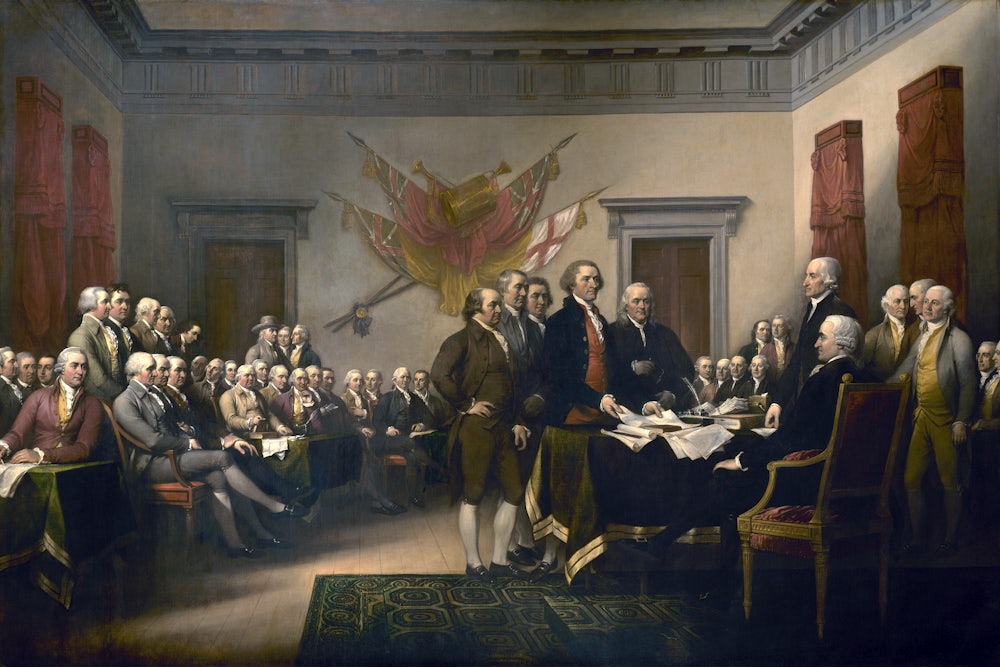In the mid-1940s, Edmund S. Morgan, a mild-mannered young
historian, was teaching at Brown and making a name in the quiet field of early
American studies. Having published a slim, well-received collection of essays
on the New England Puritans, he might have seemed the very model of the
unassuming scholar at the outset of a modest career, satisfied to refine the
work of great forebears in a narrow field. That wasn’t Edmund Morgan. The
Second World War was over. The United States was developing an energetic
vision, which would come to fruition in 1960 with the election of John F.
Kennedy, of its new global leadership role. In keeping with that vision, Morgan
launched a bold new interpretation of the nation’s founding.
Throwing out elder historians’ prevailing focus on the founding generation’s self-interest (Clarence Alvord had said that George Washington became a patriot to defend speculations in Indian land) and on its class conflicts (Carl Becker had said that the Revolution was not only over British rule but also over the rule of elite Americans), Morgan sought to identify the grand principles that the revolutionary generation agreed on. “What the colonists had to say about Parliamentary power and about their own rights deserved to be taken seriously,” he explained later.
As the U.S. began to exercise new power around the world, Morgan set out to show that the protests in the 1760s and ’70s against the Stamp Act and other British policies offered slam-dunk evidence of a founding American consensus on principles of rights. Inherent to the American character, that consensus unified the colonists, he said, inspired the Revolution, and brought about the United States. In the larger context of his work, and the work of similarly minded colleagues, the lesson was that the founding American commitment to rights persisted in postwar U.S. commitments to modern liberal democracy.
The impact of this interpretation was by no means limited to the late 1940s and the 1950s. Historians who built out what Morgan largely began—what became known as the consensus approach—turned early American history into a booming field and made big names for themselves. Born about a century ago, in Morgan’s generation, were Douglass Adair, Daniel Boorstin, Richard Hofstadter, Forrest McDonald, and Bernard Bailyn. Born in succeeding decades were Pauline Maier, Gordon Wood, Carol Berkin, Sean Wilentz, and Akhil Reed Amar, among others. As dissertation advisers for scores of scholars, many of them have held great sway in their profession.
Even more striking is their success in shaping conceptions of the American founding widely held among the American public. That power and some of its complications were seen in recent controversies involving two of the younger members of the group (though not young anymore), Wood and Wilentz. In late 2019, Wilentz organized a letter, also signed by Wood and three other historians, criticizing The New York Times Magazine’s much-discussed 1619 Project, which frames slavery, racism, and Black Americans’ struggles for equality as the key drivers of American history. The signers said the 1619 Project ignored objective historical fact and was steeped in politically influenced bias. In early 2020, Wilentz followed up with an essay in The Atlantic whose title put the issue bluntly: “A Matter of Facts.” Because these objections to the 1619 Project were made not on the basis of a competing framework but on the basis of plain fact revealed by deep expertise, they struck many readers as insurmountable on their face.
That’s how consensus history works. Anyone hoping to explore the depths of America’s not-so-consensus-filled past will run into this presumption, on the part of widely respected scholars, of their superior objectivity as a basis for higher authority. The roots of that presumption can be found in the approach launched by Edmund Morgan about 70 years ago.
It’s true that in scholarly circles, the consensus approach has been subjected to intermittent criticism for years. But it’s been reflected so thoroughly and for so long in museum exhibits, trade publishing, broadcasting, op-eds, and political speeches that its credibility remains unassailable with big segments of the interested public. I think that’s because even those scholars who are critical of the Morgan framing of the nation’s founding haven’t told the public the strange story of its dramatic and at times even unsettling origins.
I first confronted the work of Morgan and his intellectual allies and progeny in 2003. In response to the terrorist attacks of September 2001, I had begun trying to understand something of our nation’s founding history, and amid what was turning out to be the run-up to the Iraq War, I bumped into a half-submerged obstacle, another kind of war, an old one, among historians, with big winners and losers and a lot of dirty fighting. How that war was fought, how it tracked with the rise of U.S. power after World War II, and how its victors came to define acceptable styles for discussing the country‘s founding and meaning: That’s the story I have to tell you now. For it’s the consensus framing that still stands, for so many of us, as the essential truth about America.
In 1948, Edmund Morgan laid the first brick of what would become the dominant postwar narrative of the American founding in a scholarly essay in The William and Mary Quarterly that had the unassuming, even downright boring, title: “Colonial Ideas of Parliamentary Power 1764–1766.” He followed it up with further essays, on the Sugar and Stamp Acts and the colonial protests in response to those acts, which served as intellectual background to a highly influential book, The Stamp Act Crisis: Prologue to Revolution, written in collaboration with Helen Morgan, his wife. Published in 1953, the Morgans’ book would be assigned to generations of undergraduate and graduate students and widely read by a lay audience.
The book’s success can be attributed in part to a character-driven approach, feeling almost like reporting from the scene. That feeling is deceptive. By declining to present an argument, and relying instead on factual-sounding statements, the Morgans concealed a tendentious purpose. That purpose is found only in Morgan’s related scholarly essays, where the book’s argumentation can be seen in burgeoning force.
He was out to prove a peculiarly urgent claim. There was universal intellectual consistency among the American colonists, he said, regarding the moral basis of their objections to the British trade and navigation acts that led to the American Revolution. This broad claim of hyperconsistency may seem a bit strange now. Why would it matter so much to a young history professor of the late 1940s to show such an unusual degree of intellectual consistency, on one issue, among American colonials of the 1760s?
The answer lies in the nature of the hidden war that Morgan was fighting. He had two big targets to take down. One target was progressive history, as it was then known. The historian Charles Beard, born in 1874, had developed a critique of the elite economic interests that, he said, were the true engines behind the creation of the United States Constitution. To a degree possibly surprising to modern schoolchildren taught about the Founders’ fealty to high-minded principles inspired by the Enlightenment, Beard’s and other progressive historians’ focus on the Founders’ economic elitism and the lower classes’ struggle for equality was widely accepted, not only in the academy but also by the public, when Morgan was coming up.
His other target was, in the context of the day, conservative. The first half of the twentieth century had seen a lot of British-friendly scholarship of the founding crisis. That work presented Parliament’s changing policies of the 1760s and ’70s as more or less reasonable. In this reading, the protesting Americans can come off as inveterate smugglers, histrionically overreacting to tiny increments in taxation, their appeals to the great principles of liberty masking—just as in Beard’s take—self-interest.
In going up against those two elder schools of history, Morgan represented a young, questing, postwar American liberalism. He and John F. Kennedy were born less than 18 months apart. The 1961 inauguration speech, with its famous line, “[T]he torch has been passed to a new generation of Americans, born in this century, tempered by war, disciplined by a hard and bitter peace, proud of our ancient heritage,” brought to its head an eagerness to present the country as moderate, fair, and broadly middle class and to cast assertive foreign policies as the beneficent spread around the world of especially American talents for freedom and equality.
A lot of official energy, including public funding, overt and covert, went into developing that viewpoint. The Central Intelligence Agency, successor to the wartime Office of Strategic Services, didn’t just carry out a wide range of intelligence and military operations but also encouraged cultural expressions of American greatness through the University of Iowa Writers’ Workshop, The Paris Review, abstract expressionism in painting, and performances by Louis Armstrong. In the years before the failed U.S. invasion of Cuba in 1961, many romantically inclined, highly educated liberals found much mystique in the agency’s blend of scholastic thought and derring-do in defense of American civilization.
The Ivy League history departments got in early. After the U.S. entered the war, William Langer, a history professor at Harvard (Edmund Morgan completed his doctorate there that year), became chief of the Research and Analysis branch of OSS and brought in students and former students. Perry Miller, the great Harvard historian of early New England and academic mentor of Morgan, served in OSS’s Psychological Warfare Department. Yale became supremely OSS- and CIA-connected, fostering such important spies as James Jesus Angleton, who studied modernist poetry before becoming an early chief of CIA counterintelligence, as well as such famous statesmen as McGeorge Bundy, national security adviser to JFK and a promoter of American involvement in Vietnam. The postwar academic programs known as area studies, including American studies, “were manned, directed, or stimulated by graduates of the OSS,’’ Bundy himself once noted. By the time Morgan started teaching at Yale, in 1955, and took part in the rapid growth of its American studies program, the program described itself as “designed as a positive and affirmative method of meeting the threat of Communism.”
The opening of Edmund and Helen Morgan’s The Stamp
Act Crisis plays up the ancient-heritage mood. It tells of “a prophecy
delivered in the wilderness,” in a place “out of a fairy tale”: an “enchanted
castle” deep in the wild Virginia “paradise.” This turns out to be the home of
the colony’s former governor, Alexander Spotswood, who predicted as early as
1732 that Americans would always stand on their rights and never be taxed
without representation. Such mixtures of Arthurian national romantic spirit and
pragmatic colonial politics reflect the view that Morgan had been working up in
his essays in the late 1940s and early 1950s on the colonists’ responses to
British taxation. By clarifying a deep, even innate commitment to the
principles expressed in those protests, Morgan would show postwar Americans,
especially the college graduates who went on to staff the leadership class for
the next 50 years or so, who Americans essentially are and what their hopes for
the world essentially involve.
The young Morgan got his new interpretation rolling by taking on an aging lion of the imperial school. Not a big name today, Lawrence Gipson was a full generation older than Morgan and immensely important at the time. His 15-volume The British Empire Before the American Revolution, published from 1936 to 1970, is a work so dry and analytical, so empty of storytelling, that it’s almost unreadable. He took a forgiving view of British colonial policies and expressed skepticism about the colonists’ sincerity when invoking the principle of rights. Morgan saw a soft spot in Gipson’s portrayals of both British government and American colonials and focused his attack relentlessly on it.
Gipson was alleging a contradiction between what the colonists said they objected to when responding to the Sugar Act of 1764 and the Stamp Act of 1765 and what they said they objected to only shortly later. According to him, the colonists announced that they objected on constitutional principle only to what were called internal taxes—taxes collected from citizens within the colonies. The stamp tax, collected within the colonies, was internal. It therefore violated the colonists’ constitutional rights, they said, because such taxes could be imposed only with the consent of the taxed, given through representation, and the colonists weren’t represented in Parliament; only their representative legislatures could levy internal taxes. But the colonists did not object on constitutional grounds to taxes collected at ports, called external, levied to regulate the larger processes of the empire. Parliament did have a right to tax colonial trade externally; it had no right to tax colonists internally. That, according to the eminent Lawrence Gipson, was the colonists’ position—at first.
And yet, according to Gipson, when the British repealed internal taxes and instead placed duties on imports like tea, the colonists turned on a dime, switched to a different principle, and continued to protest anyway. Now they complained that these new external taxes, too, violated the constitutional right of representation: These taxes were levied not to regulate imperial trade but, like internal taxes, to raise revenue. The real principle, it now emerged, wasn’t internal versus external, but regulation versus revenue. Because the colonists got just as worked up over this new distinction as they’d been over the old one, Gipson suggested that colonial outrage, for all of its high-flown oratory of rights, originated more from a desire to continue in tax avoidance than from a truly principled opposition to some supposedly awful tyranny.
Morgan set out to disprove the inconsistency that Gipson was pointing to. If Gipson claimed the colonists switched their principles, Morgan would show that the colonists never switched, because they never objected, he said, to internal taxes exclusively, and they never acquiesced in external taxes. What they consistently objected to, early and late, was any tax, internal or external, intended to raise revenue and therefore constitutionally requiring representation. That was the constitutional principle. That was the right. According to Morgan, Americans ruggedly clung to the principle and the right. Claiming that they began by objecting exclusively to internal taxes was only to parrot a British invention, indeed a Tory libel.
Crucial to Morgan’s new approach—and for the long ramifications of his framing, as it came to dominate public discourse on the American founding—he said he was basing this contention of colonial consistency on a more fair and objective reading of the colonists’ petitions than earlier readings. Thus the fight between the older and younger historian came down to what those petitions literally, factually, said.
But it also came down to how the British literally, factually, responded to those petitions. Gipson, in depicting the colonists as overreactive, portrayed Parliament as relatively considerate of colonial petitions, in some ways even sympathetic. Morgan, like the colonists themselves, portrayed Parliament as aggravating its own tyranny by refusing even to consider any American grievances. This possibly secondary question—how did the British government respond to the petitions?—became one of the hardest-fought issues between Morgan and Gipson. Yet in the Morgans’ book, where so many students and other readers first encountered these issues, the fight remains so obscured you wouldn’t know it’s there.
I sure didn’t. I was in the New York Public Library’s research branch when I bumped into these diametrically opposed views, by two major historians, of the colonists’ petitions and their reception by the House of Commons. I was reading the Morgans’ book, and I came upon the section covering the Stamp Act debates, held in the Commons in February 1765. The book contends that the Commons was univocal in shutting down any consideration of the petitions. It goes on to say that the few members who did object to the stamp tax did so only on grounds of expediency and fairness and never on the constitutional right of representation, a principle invoked only by the colonists, and not by anybody in the House of Commons.
But this seemed strange, because I’d just read Gipson. He’d been telling the opposite story. He said some members of Parliament did speak on the question of right and even supported the colonists in invoking it.
Could two eminent scholars really be disagreeing on something as elementary as what was and wasn’t said—literally, factually—during the Stamp Act debates? Yes. It seemed they really could be. And yet both historians cite the eyewitness record of those debates, so it seemed to me a fairly straightforward job to determine which of the two I could better rely on. Nobody would have recruited me for OSS Research and Analysis, but I can get around a library if I have to, and I gave myself a simple task.
Compare the two historians’ accounts of parliamentary debates on the act. Note where and on what grounds they differ. Note the citations given for the differences, look up the primary sources, and see what they really—literally , factually, objectively—say.
According to the Morgans, the House of Commons allowed no American petition to be read into the record and debated, on the grounds of a univocal recoil, by the Commons, from the Americans’ assertion of the right of representation. The Morgans note that the Commons also had a procedural reason for not hearing the petitions—protests against money bills of any kind were routinely not heard—but they say that the important reason was the Americans’ asserting the right. That seemed like a pretty easy claim to verify in the primary record. In the Morgans’ notes, I saw that their main source on the issue was one Charles Garth. I easily found the source in The English Historical Review. A member of Parliament and participant in the debates, Garth was reporting to South Carolina’s Committee of Correspondence, and just as the Morgans say, he reported the House of Commons’ decision not to hear the American petitions.
But here’s where the trouble started. Garth provides a mass of detail on why the Commons refused to hear those petitions, and the main reason, he says, was the technical and procedural one disallowing the reading of any petitions opposing a bill regarding money, on any grounds, sent by anybody. Garth does note briefly that Virginia’s petition had been said to question the authority of Parliament to tax Virginians. That must have struck the M.P.s because it’s no technicality; it’s the great constitutional principle. Still, in Garth’s report, the procedural money-bill issue played a far more important role in the M.P.s’ decision not to hear the petitions.
In their book, the Morgans have reversed their source’s priorities. They make the money-bill issue less important to the M.P.s. They cast the rights issue as the key reason the Commons refused to hear the petitions. Their account so masterfully blends what their primary source reported with what it didn’t report that if you don’t look up the source, and don’t read it all, you have no reason to doubt that it says what the Morgans say it does.
What about the other big stand the Morgans take, in opposition to Gipson, regarding the Stamp Act debates? Their book asserts without qualification that those few M.P.s who did speak against the act objected only on grounds of inexpediency and unfairness, and never on the principle of the right. Gipson, by contrast, portrays the Commons as by no means entirely unsympathetic to the principle, and in support of his portrayal, he cites a letter from Jared Ingersoll, Connecticut’s colonial agent in London, reporting on the debates to that colony’s governor, Thomas Fitch. When I found the Ingersoll letter, I was startled to see that Gipson was dead right, the Morgans dead wrong. According to Ingersoll, William Beckford, alderman of London, spoke in the House of Commons on the right. Even more notably, Beckford denied the right of Parliament to tax the colonists.
How could the Morgans handle this glaring discrepancy between their contention that nobody spoke on the rights issue and the assertion, by an eyewitness, that Beckford did? I flipped quickly back through the Morgans’ account and saw that they handle the discrepancy with consummate ease. They erase it. They mention Beckford exactly once, not speaking on the colonists’ rights but bringing a motion to adjourn the session; then they never mention him again. In the Morgans’ book, Beckford’s speech in the debate doesn’t exist, so he can’t speak in favor of the colonists on the right, and Parliament remains univocal in ignoring a principle defended only by Americans.
This is why the text of The Stamp Act Crisis reads
so smoothly and seems so calmly factual. A major impression has been created,
not by marshaling an argument, with all the muss and fuss that that entails,
but by misrepresenting the evidence most relevant to the thesis. And the
Morgans were unlikely to be caught making this move. What general reader could
be expected to hit the bump and start wondering about it?
Let’s face it: In the end, of course, the American petitions weren’t heard by the House of Commons. The Stamp Act passed handily. So forget those debates. Even more germane to the Morgans’ undercover assault on Gipson were their sharply differing views of what the protesting Americans said they were protesting. Do the petitions really show the colonists consistently rejecting the internal/external tax issue, as Morgan insists a fair and objective reading shows? Did the colonists really hold firm, from as early as 1764, as he says, to a fundamental American principle, the right of representation in all taxes, internal or external, imposed not for regulating trade but for raising revenue?
No. They didn’t. Not even close. To find that out, though, you have to put the Morgans’ book down and read Morgan’s scholarly essays, which led to the book. The book engages in flat-out erasure, but the essays do have to go into detail, and reading them makes clear that, contrary to Morgan’s assertions, the primary record offers a multitude of examples of well-informed colonists taking contradictory, confused, ad hoc positions on the great principle of taxation and right. So many examples of inconsistency pop up, in fact, that every time Morgan stomps one down, he has to wheel around and stomp down another. You can see him learning, when working on the essays, what the book will have to steer so majestically around.
For one thing, Morgan has to rule out what Benjamin Franklin said in the 1760s about parliamentary taxation in the colonies. “I am not much alarmed about your schemes of trying to raise money on us,” Franklin assured Richard Jackson, an M.P. and agent in London for some of the colonies—contradicting Morgan’s assertion that all American patriots always objected to any tax intended to raise revenue. When living in London, Franklin testified in the House of Commons to the supposed all-importance to Americans of a bright constitutional line between internal and external taxes. There’s no denying that Franklin relayed to the British government an American position opposite to the position that Morgan says Americans consistently took.
There’s no denying it, so Morgan doesn’t deny it. He suggests instead that Franklin’s view can’t be counted against the claim of a characteristic American consistency on principle, because Franklin was inconsistent with the principle, so not characteristically American. Franklin could be a wily situational advocate, and he took other positions on the issue as well. Where he said things in keeping with Morgan’s vision of the American position on taxation, Morgan notes them; where he contradicts Morgan, he gets pushed to the margins.
Another thing Morgan can’t deny is that in many pamphlets and newspaper pieces, the colonists made constitutional objections exclusively, at first, to internal taxation. He therefore rules out that whole category of publishing as unreflective of American views. For him, only the legislatures’ official petitions to Parliament count as evidence. All of those petitions, he says, denied Parliament’s right to tax Americans for revenue, on the grounds that Americans weren’t represented in Parliament, and all of them avoided making the internal/external distinction.
But by no means did all of the petitions deny Parliament’s right, or avoid making the internal/external distinction, and you only have to read the petitions, not just to find that out but also to watch the young Edmund Morgan building a misleading picture of them. It’s a hard lesson—it was for me—in the ways of scholarly sleight-of-hand.
Here’s how it works. Morgan begins with solid fact. New York, he says, was firm in linking the right of representation not to the internal/external distinction but to the revenue-raising issue. It’s true. The New York petition explicitly denied, on the basis of the constitutional right of representation, Parliament’s legal power to tax Americans for the purpose of raising revenue, and because New York also didn’t expressly limit its objections to internal taxes, as other petitions did, it also avoided acquiescing in external taxes’ constitutionality. With New York, Morgan stands on solid ground.
Right away, he gets shifty. Turning to Virginia’s petition, he calls it “almost as plain” as New York’s. But Virginia’s petition limits its objections, expressly, to internal taxes. It doesn’t do so by implication but by explicitly demanding that the colony be governed by its own laws “respecting their internal Polity and Taxation.”
The limitation imposed on “taxation” by the adjective “internal” will seem clear to many readers, but Morgan says it’s not. In that phrase, he says, Virginia intended “internal” to modify only “polity” and not “taxation.” That’s because the phrase appears in other petitions too, and some of them underwent changes that really do make “internal” not modify “taxation.” Such variation might seem to many readers to indicate a certain inconsistency in the American position. For Morgan, the versions where “internal” doesn’t modify “taxation” become the standard, and he can thus inform us that we err in thinking that, in the Virginia petition, an adjective modifies a noun it clearly modifies.
Given the acrobatic extreme that “internal polity and taxation” drives him to in the essay, it’s no surprise that in their book, the Morgans characterize the Virginia petition in only one misleading sentence, quoting a different section of the text and never even alluding to the pesky phrase on internal taxation. You’d never know about the acrobatics—or about the phrase “internal polity and taxation”—unless you read the essay.
New England’s petitions make Morgan’s essays strain even harder. He acknowledges that Rhode Island, Massachusetts, and Connecticut took what he calls a “less precise” approach than other colonies. Calling Rhode Island imprecise may be fair enough. Roping in the Massachusetts and Connecticut petitions is fantastically unfair, both to the petitions and to the unsuspecting reader. Because the Massachusetts petition, revised with input from the governor, backed off an earlier draft’s categorical denial of Parliament’s right to tax for revenue in any way, internal or external, the officially submitted draft did end up making the constitutional distinction between internal and external taxes that Morgan says Americans never made in official petitions. Now Morgan has to contradict his own classification of legislatures’ petitions as the sole useful barometer of American opinion. He plays down the petition. He plays up a related letter that Massachusetts sent to London, as well as a pamphlet by the lawyer James Otis, which do refer to the revenue issue and deny the internal/external distinction. In this exceptional case, a letter and a pamphlet are deemed more official than the petition, because they express the view Morgan calls official, and the official documents don’t.
But it’s the Connecticut petition that finally drove Edmund Morgan off the deep end—and drove me around the bend.
Morgan tells his readers that Connecticut was guilty of the same ambiguity as Rhode Island, whereas in fact, the Connecticut petition was the loudest and clearest of all in making the distinction that Morgan says Americans never officially made. Just reading the Connecticut petition demolishes Morgan’s case, already tottering, for consistency of principle in the early American protests. For one thing, Connecticut explicitly objected only to internal taxes. But it also went all the way and explicitly endorsed the right of Parliament to tax externally. Having demonstrated at great length the unconstitutionality of internal taxation, the petition ends by actively proposing a constitutional means of raising revenue in the colonies “by a duty … on the importation of Negroes, and on the fur trade &c.”—i.e., external taxes.
So Morgan does his damnedest to make what the Connecticut petition says disappear. In one place, he admits that it “came as close” as any petition ever did to asserting a parliamentary right to tax externally. In another, he acknowledges Connecticut’s external tax proposal for revenue, while resorting to the classification scheme, labeling the petition not a petition but a pamphlet. Once he compromises with it, calling it a “pamphlet approved by the Assembly.” And once he admits that the document was written by a committee, “deputed,” as he puts it, by the assembly. Still, he says, it wasn’t addressed to King, Commons, and Lords, as petitions normally were, and was circulated in published form within the colony, making it just a pamphlet.
But that’s not what the Public Records of the Colony of Connecticut say about it. Those records are cited by Morgan, but so selectively that I had to read the relevant section closely. The record says that in order to prepare an address to Parliament, the committee was charged by the Connecticut legislature with presenting reasons why internal taxes, specifically and exclusively, are unconstitutional. It’s true that, as Morgan says, those reasons were then circulated in pamphlet form within the colony; the document is readily available in that form today, with Governor Fitch given as its author. Yet the legislature approved the contents in full, and it ordered copies sent to Richard Jackson, who normally presented petitions to Parliament. With the Connecticut petition, as with Benjamin Franklin, Morgan spends enormous intellectual energy trying to make American ideas seem less thorny and complicated—simply less interesting—than they really are.
What emerges from reading all of the 1764 petitions is that only New York’s took the line that Morgan says they all took. To call him less objective and factual than he claims to be would be putting it far too mildly. His whole story of an early American consistency on principle is made up. And he misrepresents objective fact to support it.
Morgan might easily have mounted an argument to refute Gipson’s reading of American inconsistencies as hypocritical: Gipson, too, cuts corners. Morgan might have shown that the colonists gained a more consistent official position over time. Connecticut did come to a better understanding of the taxation issues. Franklin may always have had a more consistent private position than he was willing to express in 1766; in 2002, Morgan published a biography of Franklin for general readers that, though skeletal and breezy, briefly traced Franklin’s developing thought on the Stamp Act matter. In the late 1940s and the 1950s, though, in keeping with cultural and political imperatives of the day, Morgan’s whole effort was to delegitimize any idea that was out of keeping with the notion of American principles of right as innate, and therefore fixed. The colonists’ ideas, not their interests, were paramount, but any evolution in their ideas was anathema. He was out to define something essential in the American character and thereby create a new master narrative, and to achieve that end, he concocted a false portrayal of the colonists’ petitions.
And he supported that narrative by claiming a firmer grasp on fact and a clearer window on truth than his competitors. To this day, concoctions of the American past invoke fact and truth in just the same way. One more problem with the 1764 Connecticut petition exposes the lengths to which such concoctions have often been driven. When reading that petition, something kept bugging me about its title, a long one, typical of the period: “Reasons why the British Colonies, in America, should not be charged with internal taxes, by Authority of Parliament; humbly offered, for consideration, in behalf of the colony of Connecticut.” The title alone—“in behalf of the colony of Connecticut”—shows that the document is an official petition, not a pamphlet. Morgan’s calling it a pamphlet would have to be flatly contradicted simply by his reference to the document in his text, and how on earth could he have dealt with that?
Back I go to look at Morgan’s first important reference to the Connecticut petition. It’s in the essay that I’ve called the opening lob in his decisive postwar reframing, “Colonial Ideas of Parliamentary Power 1764–1766.” That’s where he began the process of redefining the American founding in terms of grand principles publicly associated with the postwar emergence of U.S. power around the world. More than 50 years after the essay was published, the U.S. was taking up a global war on terror and I was at a table in the New York Public Library wondering how Morgan’s reference to the Connecticut petition’s title wouldn’t, just in itself, wreck the thesis underlying a framing of the national founding that had prevailed, all my life, in elite policy circles, and with the American public.
The title didn’t wreck the thesis because, in his reference to the petition, Morgan changed the title. Here’s what he calls the document: “Reasons why the British Colonies in America should not be charged with Internal Taxes, by Authority of Parliament.”
Absent is “humbly offered, for consideration, in behalf of the colony of Connecticut.” Without the legislature’s imprimatur, the document might easily pass for a pamphlet.
This was peer-reviewed scholarship. Now you know something about how the Morgan framing works.
Nobody with a sincere interest in finding out what happened in the past is supposed to have to do what I did. We want to believe that arguments mounted by eminent historians will be at least somewhat transparent; that we may have some basis for evaluating the evidence they rely on; that we won’t have to rebuild the case, on our own, from scratch.
But it must have seemed to the young Edmund Morgan that all faith in U.S. commitments to rights and liberty would crumble to dust in the face of the slightest acknowledgment of any mixed motives in the nation’s founding. In 1956, in a very brief and enduringly popular book, The Birth of the Republic 1763–1789, he took on American self-interest directly and placed it in a providential context. Yes, he admits there, self-interest existed at the founding. It’s one of the more thrilling features of the founding, he says, that every time self-interest raised its head, it combined with principle and flowed toward higher aims. That’s the magical American thing, to him. And thanks largely to Morgan, it became the magical American thing to many Americans.
I can assure you that consensus historians by no means imitate Morgan’s postwar work on the founding or move in anything like lockstep. They’ve produced major scholarly works of great nuance and sway, with major differences. Famous examples include Maier’s Ratification, Wood’s The Radicalism of the American Revolution, Wilentz’s The Rise of American Democracy, Bailyn’s The Ideological Origins of the American Revolution, Berkin’s A Sovereign People, Amar’s America’s Constitution, and Jill Lepore’s These Truths. Thanks to these and other works, consensus ideas have formed the preconceptions of at least two generations of educated Americans, including the leadership class, and the overall effect has been just what Morgan wanted: sharply diminished attention to economic interests and class struggles among founding-era Americans. Ideas, not interests, dominate the narrative. The ideas point the way—with a multitude of qualifications, disclaimers, and criticisms—to an ongoing settlement of conflict in the flowering of the American achievement: liberal democracy.
That’s the legacy of Edmund Morgan’s success. Much of it can be attributed to a way of writing. Consensus historians speak with Olympian certainty. They’re not trying to create a framing—they’re stating the facts. There’s no political agenda—they’re telling us how things were. We should listen—because they know. In the face of a challenge, unflappability can collapse quickly into testiness. In 1994, Gordon Wood, reacting to a revival of class-oriented critiques of the founding, made a run for the high ground even while sulking over being left behind. “I know it is naive and old-fashioned to believe,” he wrote, “that our responsibility as historians is merely to describe the past as it was and not to manipulate it in order to advance some present political agenda.”
That’s what consensus history tells us to believe: It holds a position so far above present influence that it can maintain the one true angle on the past “as it was.” We can easily see, if we take our own look, that the consensus past isn’t the past as it was. In Morgan’s work on the colonists’ petitions, it’s the past as it manifestly wasn’t. The consensus mode has produced a vast and important body of history, based on a claim to superior objectivity that was never anything but attitude.
For a notable recent exercise of attitude, and an example of the persistent public success of the early Morgan style, I’ll end my long journey with Sean Wilentz’s 2020 Atlantic essay criticizing the 1619 Project. The essay’s assertions and ways of arguing for them make it a classic of the early-Morgan genre: Wilentz places his criticism in the loftiest possible context. Fending off recent assaults on objective fact by President Trump and others, he takes up a mission to wield expertise and objectivity in defense of truth, liberalism, and democracy.
His essay responds in part to one of the 1619 Project’s most controversial claims: that preserving racial slavery was a prime motivation for declaring American independence. In the British Somerset decision of 1772, a judge ruled that an enslaved man couldn’t be held in bondage, and the man was freed. The 1619 Project claims that Somerset planted a fear in American slaveholders that the British government would abolish the institution in the colonies. Hence the American countermove toward independence. To shoot down the Somerset argument, and thus shoot down preservation of slavery as a motivation for declaring independence, Wilentz unrolls an impressive list of statistics to prove that there was no significant American reaction to Somerset at all.
Just six newspapers in the South, he says, published only 15 reports about the case. Virtually all of those few reports were brief. There was more coverage in American papers of the intrigues of the Queen of Denmark, and most of the Somerset coverage ran in a tiny font on the second or third page of four-to-six-page papers.
Done and done. Well-informed people commenting online on Wilentz’s essay considered the case closed, and why wouldn’t they? When a renowned Princeton professor makes such a masterful display of archival and statistical research, coupled with such evident erudition in eighteenth-century publishing, expertise and facts must win the day.
But the expertise on display is in the art of the bluff. The facts lack the context that gives them meaning, which turns out to be pretty much the opposite of what Wilentz says it is. He seems to have gotten all of it—even the mention of the Queen of Denmark—from a single scholarly paper, “Colonial Newspaper Reaction to the Somerset Decision,” by Patricia Bradley, presented in 1984 at the annual meeting of the Association for Education in Journalism and Mass Communication. He doesn’t cite it. That paper didn’t include the three newspapers that were published that year in North Carolina and Georgia, skewing Wilentz’s stats misleadingly downward, but more important, the six newspapers that, as Wilentz says, did report on the case were all of the papers published in those colonies that year. So it would be a lot more objective to say that Somerset was covered by every paper in all of those colonies than to say that only six covered it. The coverage appeared not on front pages but on pages two and three, and in smaller fonts, because Somerset was foreign news: In the eighteenth century, the importance of news items wasn’t signaled by font size and page placement. Anyway, Southern colonists didn’t get much news from local papers. They relied on London publications, which reported heavily on Somerset. Nothing that Wilentz has rolled out in tones of such grave authority and such impressive performance of high expertise supports his claims.
But how would I know all that about eighteenth-century news, and the scholarly paper that Wilentz relied on? Did I go back to the library and learn, on my own, everything one would have to know?
I couldn’t have learned that on my own. The facts I’ve paraphrased come from a deeper layer of scholarship than any nonspecialist can achieve: that of Joseph M. Adelman, associate professor of history at Framingham State University and author of Revolutionary Networks: The Business and Politics of Printing the News, 1763–1789. At “The Junto,” a lively group blog by junior scholars of early American history, Adelman published a brief and thorough clarification of the issues that Wilentz’s essay muddies so badly, based on his work with the relevant primary record. The post is fun to read because a scholar is showing us one of the things that historians can do and that we can’t. It has a kind of forensic playfulness.
Adelman can be so confident because he’s frank about what he does and doesn’t know and can and can’t prove. That approach is a marked departure from the one Wilentz and others inherited from the Morgan framing. It means that I have to admit the possibility, of course, that Adelman is mistaken as to where Wilentz got his information—and that I’m therefore wrong about some of what I’ve said about Wilentz—and even admit that some of Adelman’s claims about eighteenth-century printing might be subject to dispute. But what I think is that in a blog post based on deep research, Adelman has demolished not only Wilentz on Somerset but also, more importantly, an entire approach to so-called fact. That’s one kind of scholarship. The other kind, mighty and eminent, has all too often depended on bravura degrees of distortion. When the past is invoked to stiffen the sinews of an epoch’s moods, bear out political imperatives, dominate the narratives of national heritage, and hold the center of middlebrow culture against all comers, mightiness and eminence become both end and means. Edmund Morgan always took an unassuming tone, but mightiness and eminence are what he achieved.
That’s what the 1619 Project wants, too: to own American exceptionalism, define a foundational national character, build a platform for determining public understanding of our history for generations to come—to develop, ultimately, a new consensus regarding what the project sees as the highest imperatives of learning history. Times have changed. The Morgan framing was launched at universities. The 1619 Project was launched at a legacy media brand, abruptly connecting itself, for reasons of its own, to a particular reading of the nation’s past. While some might presume that a framing launched at the Ivy League in the 1940s would have the edge on objectivity, I think my experience shows otherwise. Another difference between the Morgan framing and the 1619 Project: The project admits to being a framing, and to having politics.
But the new young Morgan shouldn’t be expected to look like the old young Morgan. What firmly links the 1619 Project to the Morgan framing is a vaulting cultural ambition. In the grip of such ambition, the overriding need is to win, and that can’t be done, I once was forced to learn, without erasure, distortion, and dissociation from the messy realities of the past. At thirtysomething, Edmund Morgan began to have a major influence on his time. Long before he died, in 2013, at 97, he’d become the revered granddaddy of founding history. There was a high cost to that influence. In the history profession and other powerful institutions, dissociating from messy realities is one of the ways the U.S. advanced its cause at home and abroad. Now we may be seeing liberal democracy in crisis, at home and abroad, and if American cultural endeavor is to have some part in a renewal, and even an improvement, it can’t rely on the tactics of what I’ve called the Morgan framing. Insupportable assertions, argumentative slipperiness, slapping away criticism, acrobatic bedazzlement, presumption of authority, displays of testiness: Any genuinely fresh confrontation with the past would have to scrap those tricks.
It’s not fair. The tricks endowed at least two generations of thinkers, overwhelmingly white and male, with unearned authority and influence. Fairness would dictate that members of groups not overwhelmingly white and male get a turn at practicing the same tricks, for the same rewards.
But we’re members of the public, you and I. Getting in our heads is how the great victories in America have always been won. To avoid being forever bluffed, forever tricked—forever Morganed—our descendants will have to be warier than we were, and maybe more playful, too.








